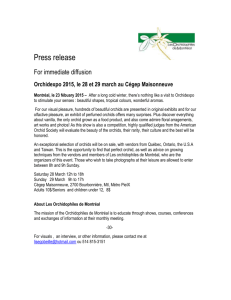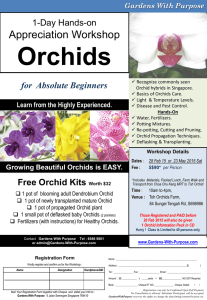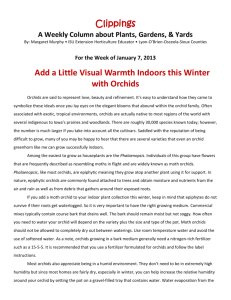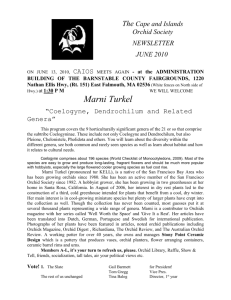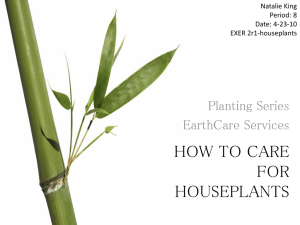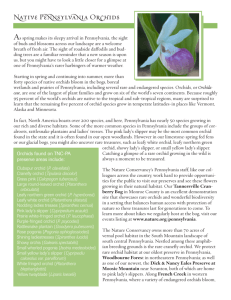SOUTHERN ONTARIO ORCHID SOCIETY NEWS June 2011
advertisement
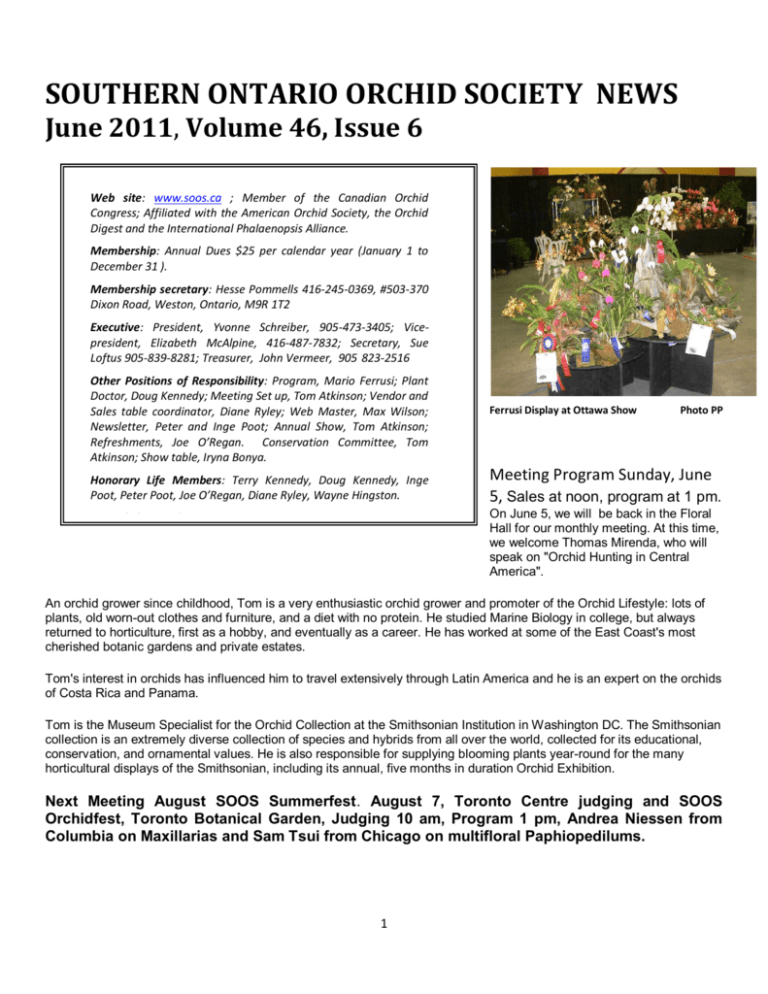
SOUTHERN ONTARIO ORCHID SOCIETY NEWS June 2011, Volume 46, Issue 6 Web site: www.soos.ca ; Member of the Canadian Orchid Congress; Affiliated with the American Orchid Society, the Orchid Digest and the International Phalaenopsis Alliance. Membership: Annual Dues $25 per calendar year (January 1 to December 31 ). Membership secretary: Hesse Pommells 416-245-0369, #503-370 Dixon Road, Weston, Ontario, M9R 1T2 Executive: President, Yvonne Schreiber, 905-473-3405; Vicepresident, Elizabeth McAlpine, 416-487-7832; Secretary, Sue Loftus 905-839-8281; Treasurer, John Vermeer, 905 823-2516 Other Positions of Responsibility: Program, Mario Ferrusi; Plant Doctor, Doug Kennedy; Meeting Set up, Tom Atkinson; Vendor and Sales table coordinator, Diane Ryley; Web Master, Max Wilson; Newsletter, Peter and Inge Poot; Annual Show, Tom Atkinson; Refreshments, Joe O’Regan. Conservation Committee, Tom Atkinson; Show table, Iryna Bonya. Honorary Life Members: Terry Kennedy, Doug Kennedy, Inge Poot, Peter Poot, Joe O’Regan, Diane Ryley, Wayne Hingston. Ferrusi Display at Ottawa Show Photo PP Meeting Program Sunday, June 5, Sales at noon, program at 1 pm. On June 5, we will be back in the Floral Hall for our monthly meeting. At this time, we welcome Thomas Mirenda, who will speak on "Orchid Hunting in Central America". Annual Show: February 11 – 12, 2012 An orchid grower since childhood, Tom is a very enthusiastic orchid grower and promoter of the Orchid Lifestyle: lots of plants, old worn-out clothes and furniture, and a diet with no protein. He studied Marine Biology in college, but always returned to horticulture, first as a hobby, and eventually as a career. He has worked at some of the East Coast's most cherished botanic gardens and private estates. Tom's interest in orchids has influenced him to travel extensively through Latin America and he is an expert on the orchids of Costa Rica and Panama. Tom is the Museum Specialist for the Orchid Collection at the Smithsonian Institution in Washington DC. The Smithsonian collection is an extremely diverse collection of species and hybrids from all over the world, collected for its educational, conservation, and ornamental values. He is also responsible for supplying blooming plants year-round for the many horticultural displays of the Smithsonian, including its annual, five months in duration Orchid Exhibition. Next Meeting August SOOS Summerfest. August 7, Toronto Centre judging and SOOS Orchidfest, Toronto Botanical Garden, Judging 10 am, Program 1 pm, Andrea Niessen from Columbia on Maxillarias and Sam Tsui from Chicago on multifloral Paphiopedilums. 1 Tour of Orchid Growers June 11 and 12, 2011 Grower Doug & Terry Kennedy Location 15 Wilmac Crt. Gormley Contact 905-727-3319 Date(s) & Time Open Sunday June 12 10 a.m. – 4 p.m. Orchids in Our Tropics Wayne Hingston 7 Hillings Drive Joe and Patricia Diciommo 414 Upper Ottawa St. Calvin Wong 53 Howard Road Ajax Hamilton Newmarket Eric & Ellen Lee 905-389-9339 416-471-6939 Saturday June 11 10 a.m. – 3 p.m. Saturday June 11 9 a.m. – 4 p.m. Sunday June 12 11 a.m. – 3 p.m. 905-478-8398 Newmarket Crystal Star Orchids 905-686-5697 By appointment only By Appointment Saturday June 11 & Sunday June 12 By Appointment Only Only 4 Leahann Dr. Joe O’Regan Scarborough 416-759-2538 Sunday June 12 1 – 4 p.m. 416-622-4867 Iryna Bonya 22 Crendon Drive or Sunday June 12 Toronto 416-725-8015 10 a.m. – 3 p.m. (cell) Rosanne Li 7 Mooreland Crt. Markham 905-294-8549 Plants for Sale 2 Saturday June 11 10 a.m. – 1 p.m. Summerfest 2011 Sunday, August 7 - The Southern Ontario Orchid Society (SOOS) is pleased to announce that Andrea Niessen and Sam Tsui will be guest speakers at this year's Summerfest. This annual event is open to all SOOS members, as well as to bona fide members of other orchid societies. As this event is held on the August long weekend - Sunday, August 7, 2011 - it is not too early to plan your own calendar around this event. This is the meeting where we all bring our favourite potluck dishes for our attendees to share. There will be 2 presentations: – – – o o plants brought to Summerfest will cost 10% to 15% more there will be approximately 100 different species please contact Andrea via e-mail and let her know the order payment: for credit cards, it must be in US$ for cash, either Canadian or US currency is acceptable. SOOS President’s Remarks Sam Tsui: News in multifloral Paphiopedilums & their culture Andrea Niessen: the Maxillarias and their diversity they will be bringing orchids for sale. Here are the details thereof: Sam Tsui: Orchid Inn Ltd. at http://www.orchidinnusa.com/ Sam is at samtsui@orchidinnusa.com people may order from Sam’s website or from an updated list which will be sent out in early June: regarding the website, please note that it will not be accurate till June 1 cut-off date for pre-orders is June 19 - for the CITES permit there will be a 10% discount for all preorders except NET price items or packages! payment: for credit cards, it must be in US$ for cash, either Canadian or US currency is acceptable. Andrea Niessen: Orquideas del Valle at http://www.orquivalle.com/ Andrea is at andreaniessen@orquivalle.com available orchids are found as follows: at the website there is a pricelist via an Excel spreadsheet – send an email to info@soos.ca to receive a copy cut-off date for pre-orders is June 10 pre-orders and a discount: there is no discount for pre-orders pre-orders have the listed price (of the web site or spreadsheet) and no extra cost Fellow orchid aficionados: Thank you goes out to those of you who brought in treats to share for our May 1st meeting. The letter of the month for June will be the letter “M”. We are asking anyone whose last name starts with the letter “M” to bring in a treat to share. These treats should be finger foods only i.e. something that can be picked up with your fingers and does not require a plate or fork. The Tour of Orchid Growers will take place on June 11th and 12th. This will give members of our society a chance to visit and see how others are looking after their orchids. There will be eight different growers to visit. Please respect the dates and times posted in the chart. Contact information is shown for each of the members who have generously allowed us to visit them. Our May 1st meeting was held in the Garden Hall and served as an introduction to this room. As was apparent to those in attendance, we will have to make some accommodations that are necessitated by the smaller space. Your executive, to make the most effective use of the space, will reconsider the arrangement of the various tables. We will not be using the Garden Hall again until April 2012. Due to the acoustics in this room, I found that sound traveled very well. This means that conversations that might not be heard in the Floral Hall are disruptive to meetings in the Garden Hall. Please be considerate and keep 3 Fall New Comers’ Meetings your private conversations until the social break. Wayne Hingston (905-686-5697) will once again present his excellent series on the culture of the most popular types of hobby orchids. These sessions are for members who have just started in orchids and will be presented at the Toronto Botanical Garden Board Room on the following Tuesday evenings at 7 pm: A number of changes will be made to the membership fees. Beginning in September 2011, the cost for a membership will increase to $30.00. Effective immediately, for all new members opting to receive the newsletter via regular post, an additional charge of $15.00 will be added to their membership fee. A current member wishing to change from e-mail to regular post for receipt of the newsletter will also be assessed this additional charge. Our monthly newsletter is currently available via email or regular post. Almost half of our members have chosen not to receive the e-mail version, and the cost of mailing the newsletter to these people uses up most of all of the membership fees collected. If at possible, we are urging all current members, who have not provided us with an e-mail address to receive the newsletter, to do so. Sept. 27, Oct. 18, Nov. 22, Dec. 13, and Jan. 17 (2012). AOS REP. REPORT FROM SHREVEPORT MEETINGS APRIL 27 to MAY 1, 2011 Orchidfest is fast approaching. Please remember that this event will now, with exception of beverages, be totally potluck. All the food, main courses, salads and desserts, will be brought in and shared by our members. What we bring to share, we will all eat. After a three hour delay leaving Buffalo Airport and then flying over the tornados that caused the severe damage in the lower states Conni and I arrived at our hotel in Shreveport at midnight not 7 pm as scheduled. The weather the rest of the time was nice, actually got into some humidity a lot sooner than I would like. This is your orchid society. What are your hopes, ideas, problems or complaints about the society? What are we doing well? What could we be doing? We can always use fresh ideas. Are you willing to contribute? We need someone to step forward to act as show chairperson for our 2012 show. Could that person be you? Too big a job for you? Get your feet wet by joining the executive – there are jobs looking for people. The election for the 2012-2013 executive will take place at the December 4th meeting. Talk to me at a meeting; e-mail me at yvonneschreiber68@gmail.com, or phone me at 905-473-3405. Yvonne Schreiber Some of the things that might interest SOOS and AOS members are that the AOS Building does have an offer on it and there some hurdles to jump, but it seems that the sale will be complete some time this fall. With that going on the Board is actively looking for a new home, most likely a Botanical Garden. Here the AOS would remain the AOS, produce Orchids magazine, keep the AOS Judging System the best in the World and keep as many features as possible on going, but save greatly on many shared needs. The new web site is in Beta testing and could be on line by June 1. Along with this there will be a new format for AQ Plus called Orchids Plus, this will be mainly on line and will be updated everytime you access it. All subscribers will Welcome New Member Hideh Tabatabaie. Hideh grows her orchids on a windowsill and learned about us from a friend. 4 receive a disc to start off and then will be updated on line. Cymbidium Sweetheart ‘Sensation’, ? There is also to be a new blog for training and other orchid info. Epicatanthe Volcano Trick ‘Fireball’, John Vermeer. Phalaenopsis King’s Landing West, Don Wyatt Rhyncholaeliacattleya Kat E-Sun, John Vermeer. Those of you that are members have I'm sure seen the great improvement in Orchids magazine and from the list of articles they have lined up it will continue to be great. Rhyncholaeliacattleya Duh’s Wisdom ‘Green Star’, John Vermeer. Cattleya loddigesii, Aina Balodis. I would like to also congratulate Jean AllenIkeson for her elevation to Accredited and Calvin Wong also for elevation to Probationary. Great work! Cymbidium ensifoium #2 ‘Gin Chi’ Jay Norris. Probationary judges are required to do a major paper on an orchid judging related topic before they are advanced to Accredited status. Jean Ikeson did an extensive paper on Sarchochilus and its hybrids which will be published in a special issue of Orchids magazine by the American Orchid Society (AOS). Quite an honour that is well worth supporting. AOS is asking for small contributions to a fund that allows it to publish these special extra editions. Cymbidium Phoenix #3, Jay Norris. Cymbidium ensifoium #1 ‘Continuing Luck’ Fuk Lun, Jay Norris. Thank you all. Coming Events 2011 June 4, Toronto Centre judging, Toronto Botanical Garden, Judges training 10 am, Judging 1 pm. 5, SOOS meeting Toronto Botanical Garden, sales 12 noon, program 1 pm. 18, Montréal Centre – Jardin Botanique de Montréal Mario Ferrusi 18-19, Great Lakes Judging Center, Annual Training Seminar, Ann Arbor, MI Ottawa Show. This show is held in the arena of a recreation centre, which makes for a very spacious layout. Inge and Peter Poot put in the SOOS display. The SOOS ribbon winners were: July 2, Toronto Centre, Toronto Botanical Garden, Judges training 10 am, Judging 1 pm. 1st Place Ribbons Paphiopedilum delenatii, Yvonne Schreiber 16, Montréal Centre – Jardin botanique de Montréal Macradenia multiflora, ? August 2nd Place Ribbons 7, Toronto Centre judging and SOOS Orchidfest, Toronto Botanical Garden, Judging 10 am, Program 1 pm, Andrea Niessen from Columbia on Maxillarias and Sam Tsui from Chicago on Paphs. Promenea Ben Berliner, Don Wyatt Paphiopedilum Jogjae, ? Dendrobium Roy Tokunaga, Jay Norris Paphiopedilum rothschildianum, Inge and Peter Poot 3 Place Ribbons 20, Montréal Centre – Jardin botanique de Montréal Brassia Rex ‘Sakata’, ? SEPTEMBER Paphiopedilum esquirolei ‘Yvonne’, Yvonne Schreiber 3, Toronto Centre, Toronto Botanical Garden, Paphiopedilum Salvador Dali ‘Yvonne’ Yvonne Schreiber. Judges training 10 am, Judging 1 pm. Dendrobium fimbriatum, Inge and Peter Poot. sales 12 noon, program 1 pm rd 4, SOOS meeting Toronto Botanical Garden, 5 17, Montréal Centre – Jardin botanique de Montréal end of April, 2011, we attended an interesting talk by : Roy Takunaga of H&R Orchids on 24-25, Central Ontario Orchid Society Show, Toronto Centre, October judging How To Grow Specimen Plants Not only did we learn lots of insightful tips, but Mr Takunaga also drew out attention to the fact that most of the tips he gave us can be gleaned from articles in the AOS publication “Orchids”. AOS Judging Results Please note, all of these awards are provisional until published by the American Orchid Society Ottawa Show April 23: Coelogyne ? CHM-AOS 86 points, Doug and Terry Kennedy He started the show with a mouthDendrochilum filiforme Orchids+ photo watering clone of Dendrochilum filiforme. In its native habitat it gets 100-150 inches (250- 375cm) of rain per year. But if you try to simulate this in cultivation by watering every day, the centre will rot. Promenea Conni AM-AOS 80 points, Mario and Conni Ferrusi Sedirea japonica ‘Crystal Star’ HCC-AOS 79 points, Crystal Star Orchids Bulbophyllum lobbii ‘J B de Montreal’ CCM-AOS 83 points Lycaste Garfield ‘ J B de Montreal’ CCE-AOS 91 points The solution of the grower was to grow the plant in a 6 inch(15cm) clay pot filled with sphagnum. Toronto Centre May 7, 2011: Odontocidium Dark Chocolate ‘Daina’s Feast’ AM-AOS 82 points, Doug and Terry Kennedy The plant was summered out of doors mounted on a swivel in a breezy part of the garden so that every bit of wind rotated the plant and PRESTO: flowers set all around the plant. Masdevallia Violet Gems ‘Starry’ AM-AOS 80 points, Mario and Conni Ferrusi Dracula benedictii CCE-AOS 90 points, Mario and Conni Ferrusi It was fertilized very little. This led to a more general discussion on how to deal with the climate to get specimen plants. Coelogyne bilamellata, CBR-AOS, Calvin Wong Aerides fieldingii, CCM-AOS, Dwayne Levy Watering: Paphiopedilum Fumi’s Delight ‘Synea’ AM-AOS 80 points, Synea Tan As long as the rainfall is less than 80 inches (200cm) per year, a good way to reduce the heat is to place the plant under shade cloth. The heat escapes through it, but the rain flushes the plants under the cloth. You can then do continuous feeding at a low rate, but if there is no rain you must flush thoroughly at least once per year –once per month is better. See an article on leaching on page 372-377 by Fred Bergman in the May 2004 issue of Orchids. Dendrobium Ueng Fueng ‘Crystal Star’ AM-AOS 82 points, Eric and Ellen Lee. Siderea japonica AM-AOS 81 points, Eric and Ellen Lee. Montreal Centre May 21, 2011: Muscarella kennedyi CBR-AOS, Marie Odile Fertilizing: Orchid Ramblings by Inge Poot With rain water use the MSU-RO-water special formulation fertilizer, but if your water is basic an acidified 15-5-15 formula is better. While Peter and I attended the AOS semiannual meeting in Shreveport, Louisiana at the 6 If you have orchids with different water requirements (and who has not!) use different media so that you can water them all the same. Light: The maximum light tolerance of each species has to be established and when giving plants light it is better to err on the side of a bit too much light. The most common reason for no flowers is insufficient light! Specimen plants do better when they are disturbed as little as possible and as a result weeds can become a severe problem. At H&R Oxalis corniculata is their bane! (I wish it were the only bane in my plants!) Orchids has two articles on how to combat them , one by Susan Jones in the May 2004 issue on pages 340 -342 and the other in the “Orchid Pests and Diseases” 2002 booklet in Thomas Sheehan‟s section on “Physiological Disorders of Orchids”. Consult “The Principles of Light” by Erik Runkle, Orchids May 2008, pages350-353 for information on light quality for different light sources and maximum suggested light intensities for different genera. The speaker brought up the point that light intensity recommendations have to be adjusted to the latitude the plant is grown at. A Dendrobium aggregatum grown all year round in Hawaii can take 6000-7000 foot-candles of light. When you try to give this amount of light to a plant grown further north it will burn. It won‟t put up as hard a growth. Susan Jones also wrote a good article on slug and snail control in the April 2002 issue of Orchids. On the same topic, Bev Tall wrote in the January-March 2004 issue of the ORCHID Digest that spreading diatomaceous earth around the perimeter of the orchid growing area/greenhouse will cut down on the pests. Also remember that at 115 - 120F (46-49C) is the temperature at which orchids “cook”. Too much light without good ventilation can be toxic! This May 2004 issue is full of cultural information on how to get specimen plants of Dendrobium cuthbertsonii, Sophronites (Cattleya) species, how they are grown in Japan, and how to grow Podangis dactyloceras, Stanhopeas (Yea!), how to water Vandas and how to grow Brassia intergenerics. Repotting: This section is based on an article in the May 2006 “Orchids“ by Mary Jo Gilsdorf: “Adaptive Repotting Approach”. It means matching the plant to the medium. With a minimum temperature of 48F(9C) and a maximum of 94F(31C) the charming little Dykia hendersoniana with little grape-like clusters of white flowers with rose-pink lips) was grown with ease by the late Fred Fuchs either mounted, in a basket or even in an empty plastic tray! For hints on specimen culture consult Robert Fuchs‟ (Fred‟s son‟s) article in the September 2004 issue of Orchids, pages 672679. It discusses how to get specimen plants in the Vanda, Dendrobium and Cattleya alliance. Cattleya aclandiae is potted in a net pot with huge chunks of bark, because its roots like to be exposed and will photosynthesize. Roots: Another example is Broughtonia sanguinea. It likes bright light and needs a very coarse potting medium with Styrofoam on the bottom to get good air and drainage. A good way to pot it is to jam it with coarse bark into the top third of the pot and leave the roots dangling free in the bottom two thirds. A clear pot is helpful. When you get a plant with thick roots and the plant looks like a succulent, chances are pretty good that the plant wants to have exposed roots with which to photosynthesize. (Note: Any plant whose roots turn green when watered thoroughly will photosynthesize with the roots eg Vandas according to Martin Motes) The best plants always have good roots. 50% of plant mass should be roots and in some plants it should be 60-70%. (Reference: Joseph Arditti‟s book “The Fundamentals of Orchid Biology”, 1992): Velamen makes orchid roots different. It is a spongy absorbent covering for the roots and it leads anything it mops up to the root tip where it is absorbed. Some species can photosynthesize in their roots. For example: Vanda roots are self-sustaining and need no sugar from the rest of the plant. A more extreme example is Grammatophyllum scriptum and the even bigger G. elegans. It needs lots of air if it is not to rot. The best way is to jam the plant into the pot with big chunks of styrofoam. When treated this way, they had these supposedly warm growers survive to near freezing dips in temperature. 7 Pests: Orchids”. It gives the conditions that trigger flowering for many orchids, but states that the triggers for many genera such as Miltonia, Oncidium, Vanda and Zygopetalum are not known. The worst enemy with good culture are slugs and bush snails. They love the same conditions as orchids and must be fought with several applications of methaldehyde. To cut down on hiding and breeding spaces for these pests, covering the soil under the benches with something like landscape cloth will help. Flower Boosting Summary: Roots and Environmental conditions should be perfect. Nutrition and extra steps for specimen plants: Apply a high Calcium fertilizer one month before spike initiation at the rate of one teaspoon per gallon of water. At H&R the pH is adjusted once a year with dolomite. One month before spike initiation the plants are treated with Calcium nitrate. Extra phosphorus does not help. 3% is enough, 30% gives fewer flowers. Then once a week the plants get a calcium fortified fertilizer until the flowers open, then stop. You will get more flowers that way. Low nitrogen fertilizers should be used since ammonia and urea will favour vegetative growth at the expense of flowers. Nitrates are OK to use since they are not used by the plant. They use 1 tsp/gallon in the summer, ¼ tsp/gallon in the winter and ½ tsp/gallon in Hawaii! Calcium feeding is more complicated and Roy Takenaga plans to write an article on it for “Orchids”so watch for it. A summary of it is that Calcium is not mobile. It means that when it is deposited or used by the plant, it cannot be re-used by the plant anywhere else. It is absorbed by the root tips and moved via the Xylem to the growing areas of the plant. So it always has to be available in fertilizer when needed. The plant cannot decide to sacrifice an old leaf, say, to get calcium for the developing flowers. It has to come from the root tips. Watering is done every day for plants in loose mix in Hawaii, but here put the plants into clay pots for more humidity and faster drying. The plants are rotated periodically. Some tips about nutrition, based on an article in the June 2003“ issue of Orchids” by Jan Szyren ”Without High Phosphorus” pages 454-459, or all about the MSU fertilizer development and results. You may remember that it used to be the belief that high phosphorus (middle # in fertilizer labels) resulted in flowering. Michigan State University did experiments that proved that 3% phosphorus was good for orchids, 5% was not necessary and a high of 20% such as in 20-20-20 gave fewer flowers. The MSU developed fertilizer also has an added 8% Calcium and 2% magnesium. To finish with a concrete example: To get a spectacularly flowered Encyclia bractescens mount the plant on a swivel and give it blossom booster just before it flowers If you grow with hard water, such as well water, you will do better to use Peter‟s 15-5-15 fertilizer (it acidifies) and use MSU just before flowering. The August 2004 “Orchids”pages 602-605 had an article by Dr. Yin-Tung Wang about experiments testing the effect of Magnesium and Phosphorus applied in the Autumn to promote Flowering of Phalaenopsis. It found that neither promoted it, but phosphorus reduced the number of flowers per inflorescence when applied at a high rate. The March 2004 issue of “Orchids” pages 196-203 carried an article by Roberto Lopez and Dr Erik Runkle titled “A Reality Check :The Flowering of Encyclia bractescens in H&R display 8 photoPP PLANT OF THE MONTH Cattleya luteola 'Best Ever' HCC-AOS 78 points AOS Orchids+ picture The plant of the month went to Michael Hwang for the charming Cattleya luteola. Not easy to get even one or two flowers and known for its awkward habit of growth, this little orchid looked compact and was covered with flowers. Excellent job! Michael grows his cattleyas under lights in warm to intermediate temperatures and waters once a week. This one was a resistant bloomer in the past, but more light made her change her disposition. He recently started misting in the morning and this one really enjoys it. Congratulations, Michael! A Star is born. Crystal Star Orchids offers broker service with over 15 top orchid nurseries from Taiwan and the U.S.A, including: Ching Hua Orchids, In Charm, Krull Smith, and Sunset Valley. Our website is up and running. If you have any questions please feel free to email us at: crystalstarorchids@gmail.com or call Eric Lee at (905) 478-8398. 9 May 2011 Show Table Class First Second Third Class 1 Cattleya luteola Cattleya jenmanii Sophrolaeliocattleya Cattleya Alliance Michael Hwang Michael Hwang Midnight Doll Don Wyatt Class 2 Paphiopedilum Paphiopedilum Ho Chi Minh Paphiopedilum hangianum Paphiopedilum Fumi‟s Delight Henry Glowka Erika Lorincz Synea Tan Class 3 Phalaenopsis Vanda Alliance Aerangis stylosa and Erika Lorincz Phalaenopsis Fajen‟s Neofinetia Fireworks x Alfonso Morew Seionishiki Henry Glowka Class 5 Cymbidium aloifolium Cymbidium Lauren Nurse Class 6 Dendrobium Dendrobium Christmas Dendrobium aggregatum Chime x Oriental Smile Synea Tan Sue Loftus Dendrobium hancockii Tenny Chan Class 7 Coelogyne „Rainbow Trout‟ All Others Alex Antenaitis Specklinia [Spe.](Pleurothallis) grobyi „Andrew‟s First Communion‟ Erika Lorincz Class 8 Dendrobium Gatton Sunray Specimen Plants Tenny Chan 10 Michael Hwang falcata
